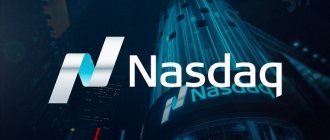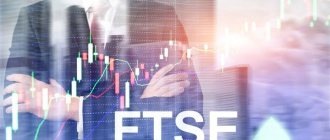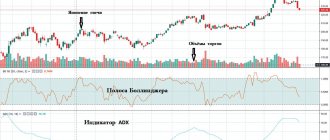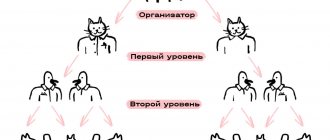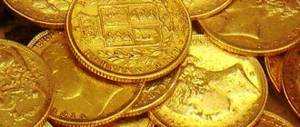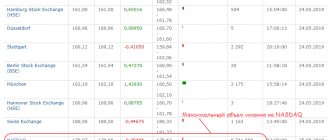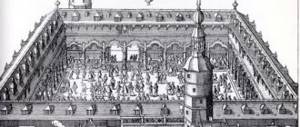One of the main American (and world) indices is the Nasdaq. Anyone who follows the state of the stock market definitely pays attention to one of the three main indices: S&P 500, Dow Jones or Nasdaq.
With the S&P 500, it's simple - the 500 largest publicly traded companies in the country are included in the index.
The Dow index includes blue chips - 30 large companies in America.
What about the Nasdaq index? It is the least understandable for investors.
And with all this, there are two indexes:
- Nasdaq Composite;
- Nasdaq 100.
How are these indices formed? What is their difference? What is the benefit for the investor?
What is the Nasdaq exchange and the history of its development
The Nasdaq exchange is the largest US stock exchange, one of the three world market leaders, and ranks 2nd in capitalization (after the NYSE). Investors associate it with the high-tech sector, but in addition to IT, companies from other areas are traded on the stock exchange: healthcare, consumer goods, industrial products, finance, etc.
Nasdaq is not only the most technologically advanced exchange, but also the youngest. Officially, the first transaction was carried out in electronic format in February 1971. But the history of development began long before this date:
- In the 30s of the last century, the US Congress decided to restore order to the stock market, where speculative and insider transactions reigned, losses and gains of millions of dollars in a matter of minutes. Self-regulatory organizations were organized for brokers to participate in them and monitor their activities. The National Association of Securities Dealers (NASD) became such an SRO. It existed for about 30 years and did not live up to the expectations of the US Congress.
- To correct the situation, an automated trading system began to be created on the basis of NASD (at first it only took into account data on each transaction with securities, and already in 1971 the first transaction was carried out in electronic format).
- The created automated system was named Nasdaq. It became the first electronic exchange. Today, pictures of brokers shouting in the crowd remain only in Hollywood films. Trade has completely moved online.
- But control over the prices for buying and selling shares and a narrow price corridor scared off speculators, and the exchange was not popular among investors. Then, in 1975, the management decided to admit to trading companies that could not get onto the largest exchanges of that time. These were mainly IT enterprises that were developing completely new digital technologies; their business was too risky for them to gain wide access to trading platforms.
- Nasdaq membership began to rise. When the number exceeded 1,000, it was necessary to organize them. In 1982, the first stock index appeared - Nasdaq National Market. After 3 years - two more.
- In the 90s of the last century, Nasdaq tried to conquer the European market. Not all attempts were successful, but in 2007, a merger with the Swedish company OMX allowed the exchange to enter the European stock market.
Complete information about current strategies that have already brought millions of passive income to investors
In 2021, Nasdaq is an entire exchange holding company, with trading platforms and offices represented in 26 countries. It includes not only the exchange, but also banks, news portals, analytical agencies, etc.
It would be wrong not to talk about the largest crisis in which the Nasdaq exchange became a participant. It was called the “Dotcom Bubble”. It was caused by the massive ruin of companies in the IT sector, whose shares grew on inflated and unjustified expectations. The result was disastrous: most of the startups were unable to develop effectively, they declared bankruptcy, and investors lost more than $5 trillion.
This rapid decline is clearly visible on the graph:
Features of work
Trading on the Nasdaq Exchange takes place 100% electronically. Information about quotes is updated every second. Opening hours: from 9:30 to 16:00 North American time and until 20:00 in the post-trade session.
There are two main trading sections:
- Nasdaq National Market (NNM) is the main market where securities of major companies are traded. To be included in this list, you must fulfill strict requirements for financial indicators and capitalization level.
- The Nasdaq Small Cap Market is a training ground for those who cannot yet make it onto the first list. Small capitalization companies are traded. It is on this site that you can find the future Google or Apple.
The trading scheme looks like this:
- there are several hundred market makers operating on the exchange;
- they compete with each other for the right to fulfill the buyer’s or seller’s request;
- if for some reason there is no profitable counter offer for the order, then the market maker closes it at his own expense;
- he accepts applications from a brokerage company that represents the interests of its client;
- Several dozen market makers can compete for the execution of one order.
Company listing includes:
- shares - 8,106 items, including Apple, Amazon, Microsoft, Alibaba, Facebook, Visa and many others;
- ETFs (index funds) – 3,000 funds;
- Mutual investment funds (mutual investment funds) – 33,858 managed funds;
- futures – 37 futures contracts, mainly for currencies and indices;
- currency, including cryptocurrency;
- goods - metals, energy resources, grain crops and other food and non-food products.
A complete list of assets traded on the exchange is presented on the official website. There is no version in Russian, so an online translator will help. A convenient screener has been made for investors. It helps you filter by capitalization, sector, trade recommendations and type of security.
How many companies are in the Nasdaq Composite?
As of February 2021, there are 2,667 securities listed on Nasdaq, but as mentioned earlier, not all types of securities are included in the Nasdaq Composite Index.
For example, the portion of Nasdaq that consists of exchange-traded funds (ETFs) is not included.
According to the fact sheet for Fidelity Nasdaq Composite Index Fund (NASDAQMUTFUND: FNCMX), a mutual fund that tracks the index, there were 2,065 different stocks and 2,035 companies in the index at the end of 2021.
However, it is important to know that since the index is weighted by market capitalization, and since some of the world's largest companies are listed on the Nasdaq, the index ranks quite heavily. In fact, the top 10 stocks in the Nasdaq Composite account for one-third of the index's performance.
With that in mind, here are the 10 largest stocks in the Nasdaq Composite:
- Microsoft (NASDAQ:MSFT);
- Apple (NASDAQ:AAPL);
- Amazon (NASDAQ:AMZN);
- Alphabet Class C (NASDAQ:GOOG);
- Alphabet Class A (NASDAQ:GOOGL);
- Facebook (NASDAQ:FB);
- Intel (NASDAQ:INTC);
- Netflix (NASDAQ:NFLX);
- PepsiCo (NASDAQ:PEP);
- Cisco Systems (NASDAQ:CSCO).
Indexes
Nasdaq calculates several indices. Let's look at the most famous ones.
Nasdaq Composite
The countdown begins in 1971. The graph of his ascent looks like this:
Includes more than 3,000 stocks from around the world that are listed on the exchange. But only ordinary, preferred and ETFs are not included in the calculation. In 1971, the initial quotation was stated at 100 points. As of September 2021, it was already 11,117, i.e. an increase of 111 times over 50 years.
Shares are included according to the principle “the larger the capitalization, the more weight the company receives in the index.” Technological enterprises account for about 50%, the remaining percentages are divided by other sectors: healthcare, consumer sector, finance, industry, etc.
The index behaves differently. A sharp rise is followed by an equally sharp fall, and recovery sometimes takes much longer than for other indices. Today experts are predicting another fall, because they are again observing the overvaluation of high-tech companies.
Nasdaq-100 Index
Includes the 100 largest companies in the non-financial sector. Most of them are world leaders in the IT sector. It is the top 10 companies on the list that make up more than 50% of the index:
How to trade on the stock exchange as a Russian investor
Any stock exchange in the world needs an intermediary so that a private investor can trade securities of companies that interest him. Nasdaq is no exception. Direct exit through a Russian broker is only possible for a qualified investor. For those who are not, there are several ways. Let's consider them.
Foreign broker
Unfortunately, the choice of a broker that provides access to Nasdaq is limited for a Russian. Today we can name:
- Interactive Brokers (IB) is the most popular option in Russia. There is no minimum threshold amount, you can trade with as little as $100 US. But there is a fee for inactivity. If the amount on the account is less than $2,000 - $20, from $2,000 to $100,000 - $10, more than $100,000 - no commission. Another plus is support in Russian. Recently, cases of denial of service have become more frequent.
- Score Priority is owned by the Russian broker Finam. There is no Russian-language support. There is a tariff without commission. Our country is one of the countries with a high level of risk, therefore a minimum deposit of $5,000 is required. There is an inactivity fee of $15 per quarter if you make less than 5 transactions per quarter. Account maintenance costs $50 per year.
- Lightspeed . The minimum deposit is $10,000, and the inactivity fee is $25 per month if the account balance is less than $15,000. There is no Russian-language support.
When you open an account with a foreign broker, you get access to instruments on American exchanges, including Nasdaq: stocks, bonds, ETFs, etc.
Exchange-traded funds on Moscow Exchange
If you want to own shares of high-tech companies, you can buy on the Moscow Exchange:
- Index fund from FinEx with ticker FXIT. It includes 90 companies in the US IT sector. Among them are Apple, Microsoft, Intel, Visa, IBM, Cisco, Oracle, etc. The management fee is 0.9%. The return over the last 5 years was 276.94% in rubles and 214.06% in dollars. Can be purchased on IIS. One share at the end of September 2021 costs 9,127 rubles.
- A new exchange-traded fund from Tinkoff is Tinkoff NASDAQ (TECH). He focuses on the Nasdaq-100 index, but does not blindly copy it, but has selected only 40 of the most popular and largest companies. The management fee is 0.79% per year, the cost of one share is only $0.0818.
- Exchange-traded fund “Technologies 100” (AKNX) from Alfa Capital Management Company. One share costs $16.59. Investment is carried out not directly, but through the purchase of a foreign ETF. Hence double commissions and double tracking errors.
Index funds are available to non-qualified investors.
Nasdaq shares on the St. Petersburg Stock Exchange
Shares of American companies, including those traded on Nasdaq, are available on the St. Petersburg Exchange, and more recently on the Moscow Exchange.
But there is another opportunity to invest in Nasdaq - buy shares of this exchange holding company (ticker NDAQ). In 2002, it went public. During this time, the share price rose from $12 to $125.37 (as of September 2021).
The company receives its main income from the following sources:
- ensuring the functioning of the market;
- consulting services;
- corporate services;
- technologies.
In addition, Nasdaq pays dividends. The last payment was in December 2021 of $0.47 per share, which equates to a 1.81% dividend yield.
Broker rating
| Broker | Open an account | Based | Adjustable | Broker type | Min. deposit | Max. credit leverage | Bonus |
| InstaForexReviews: 6 | Open account Demo | 2007 | RAUFR | NDD, ECN | 1$ | 1:1000 | +100% |
| AmarketsReviews: 5 | Open an account Demo | 2007 | FSA | NDD, ECN, STP | 100$ | 1:1000 | +20% |
| FreshForexReviews: 0 | Open an account Demo | 2004 | KROUFR | NDD,MM | 0 | 1:2000 | — |
| FIBO GroupReviews: 1 | Open an account Demo | 1998 | BVIFSC, CNMV | NDD,MM | 0 | 1:500 | — |
